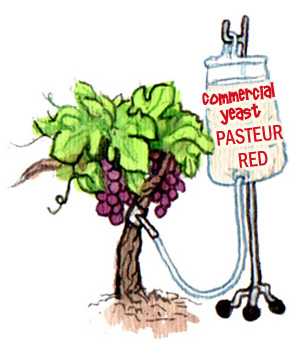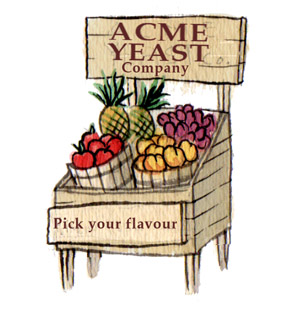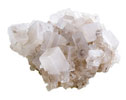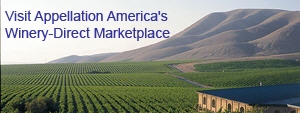

Yeast Inoculation – Threat or Menace?
Winemakers will do what they need to in their attempts to tame grapes into the wine of their vision. In fact, many will go to great technological extremes to achieve their goal. So it's surprising to Clark Smith that there should be any fuss about yeast inoculation. But there is and he thinks he knows why.
by
Clark Smith
June 27, 2008
 eads up, ye vintners! My panel’s discussion at the Portland Indie Wine Festival on “Natural Wine in the Age of Technology” was a shocking reality check for me. It emphasized the truly scary disconnect that has emerged between conventional winemakers and their formerly doting groupies. No more, guys.
eads up, ye vintners! My panel’s discussion at the Portland Indie Wine Festival on “Natural Wine in the Age of Technology” was a shocking reality check for me. It emphasized the truly scary disconnect that has emerged between conventional winemakers and their formerly doting groupies. No more, guys.
It was pretty great to be invited to bat around ideas with these folks, and my hope was to arrive at a definition for Natural Wine, perhaps even a Certification Mark. If a list of Natural Winemaking practices could be codified that’s commercially practical (unlike the ridiculous constraints of Organic Certification), I figure that many winery players will choose to participate. Win win.
It’s not as easy as it sounds. As I discussed in Natural Wine: Choosing Your Priorities, several consumer groups with different agendas are rallying under the Natural Wine flag. These groups do not want the same things. Like any political convention, careful thought and open discussion are needed to spell out those mountains which everybody in the movement is willing to die on.
We made progress. On some issues there is sensible consensus. No Megapurple, no Velcorin. Check.
 Other arenas are too subjective to be readily certifiable; you just can’t nail down what is meant by excessive oak, or excessive hangtime. Check. On other issues, there may be division: barrel alternatives have environmental and health advantages, and micro-oxygenation, though despised by many, replaces animal fining agents and may represent a return to classical practices before stainless steel and inert gas disrupted red winemaking tradition.
Other arenas are too subjective to be readily certifiable; you just can’t nail down what is meant by excessive oak, or excessive hangtime. Check. On other issues, there may be division: barrel alternatives have environmental and health advantages, and micro-oxygenation, though despised by many, replaces animal fining agents and may represent a return to classical practices before stainless steel and inert gas disrupted red winemaking tradition.
Although it is perhaps even more disreputable, reverse osmosis has nevertheless gained some acceptance in these ranks as a way to support sulfite-free winemaking, but the unnaturalness of “deconstructing” wine came up. (Why bleeding seigné for rosé isn’t also deconstruction was unclear to me.) Natural or not, the inconvenient truth remains that winemakers do a lot more RO than they generally admit, because it’s a powerful tool for quality improvement.
Whatever. Pick and choose some rules, and let us know. Kosher wine rules seem pretty silly to most winemakers, but we know what they are, so products exist. Just spell out the guidelines, and some wineries will show up for it.
Stop the Presses
So we’re cruising through the issues and suddenly, we hit the wall. Strong, very strong feeling in the room against, of all things, yeast inoculation. Really? I was, in fact, caught completely flatfooted. Flummoxed, I responded incorrectly to a question about whether my WineSmith 2004 Roman Syrah was
For someone who has never made wine, catalog claims like “encourages the fresh fruit aromas of orange blossom, pineapple and apricot;” or “believed to enhance aromas such as fresh butter, honey, bright floral and pineapple,” or “flavor attributes are often described as ripe fruit, jam, hazelnut, and dried plums on the finish” are bound to drive anyone crazy who is interested in true grape flavor expression.
OK, my bad. But so what? This was, to me, a trivial detail, one of a thousand choices every winemaking project strings together, and it simply slipped my mind. My thinking at the time must have been that without any sulfite addition, I wanted a reliable yeast working to avoid sticking or spoilage. Shoot me. But I had absolutely no clue that this issue would loom so large for the natural winers.
But when the moderator dragged out a catalog description from a yeast company, I suddenly understood. Naturally, the extravagant product claims of the corporate yeast titans Lallevin and Anchor could certainly lead any concerned consumer to panic. “My God,” I thought, “She actually believes that tripe.”
Then it hit me. Oh dear. This is not good. For someone who has never made wine, catalog claims like “encourages the fresh fruit aromas of orange blossom, pineapple and apricot;” or “believed to enhance aromas such as fresh butter, honey, bright floral and pineapple,” or “flavor attributes are often described as ripe fruit, jam, hazelnut, and dried plums on the finish” are bound to drive anyone crazy who is interested in true grape flavor expression.
A Large Grain of Salt
 Here’s the thing, folks. Any experienced winemaker will tell you that yeast companies’ flavor claims are regarded with about as much credibility as a Louisiana campaign promise. First year enology students do fermentation trials on different yeast strains, and yes, there are big initial differences. All yeasts produce esters – banana, pineapple and other fruity aromas, and the strains vary. These esters are, however, quite unstable, and a year later, the differences disappear, and are not a factor in most wines in commerce, particularly the mature reds that natural wine enthusiasts largely favor.
Here’s the thing, folks. Any experienced winemaker will tell you that yeast companies’ flavor claims are regarded with about as much credibility as a Louisiana campaign promise. First year enology students do fermentation trials on different yeast strains, and yes, there are big initial differences. All yeasts produce esters – banana, pineapple and other fruity aromas, and the strains vary. These esters are, however, quite unstable, and a year later, the differences disappear, and are not a factor in most wines in commerce, particularly the mature reds that natural wine enthusiasts largely favor.

In contrast, un-inoculated grape juice is attacked prior to the actual wine yeast fermentation (Saccharomyces) by a whole host of yeasts and bacteria, including Candida, Brettanomyces, Metchnikovia, Pichia, Kloeckera, to say nothing of bacteria such as Acetobacter (vinegar), Pediococcus (sweat socks)and Lactobacillus (PineSol) all of which may leave an indelible and lasting microbial flavor profile which permanently obscures grape expression.
It’s not black and white. Clean wines are often made without inoculation, though not as dependably. And, in certain styles. the extra flavors from “natural fermentation” can be positive. As long as there’s not too much wine at stake, "feral ferments" (the more precise term Australians use for this practice) are kind of fun. My friend Carole Shelton uses commercial yeasts for most of her Zinfandels to ensure










 READER FEEDBACK: To post your comments on this story,
READER FEEDBACK: To post your comments on this story,





